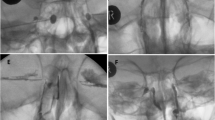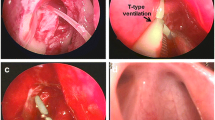Abstract
This article is to introduce office-based endoscopic revision surgery using a microdebrider for failed endoscopic dacryocystorhinostomy (EN-DCR). The authors conducted retrospective, non-comparative, interventional case series analysis of 27 eyes of 24 patients, treated by office-based revision EN-DCR using a microdebrider. After local anesthesia, anatomical failures (cicatrization, granuloma, synechia) after primary EN-DCR were treated with a microdebrider (Osseoduo 120, Bien-Air Surgery, Le Noirmont, Switzerland) in an office setting, and a bicanalicular silicone tube was placed. Anatomical improvement and functional relief of epiphora were evaluated at 6-months after revision. The causes of failed EN-DCR were rhinostomy site cicatrization (17/27, 63.0 %), granulomatous obstruction (7/27, 25.9 %) and synechial formation (3/27, 11.1 %). The anatomical success rate was 100 %, and 85.2 % cases achieved complete relief of epiphora. The surgery did not exceed 10 min in any case and no complications were observed. Office-based revision EN-DCR using a microdebrider provided prompt management of post-DCR epiphora. The portable nature and all-round ability of the microdebrider allowed office-based surgery, which offered advantage to work with the surgeon’s own well-trained office staff. Office-based revision EN-DCR can be both time- and money-saving, and might be regarded the treatment of choice for failed EN-DCR.


Similar content being viewed by others
References
Ragab SM, Elsherif HS, Shehata EM, Younes A, Gamea AM (2012) Mitomycin C-enhanced revision endoscopic dacryocystorhinostomy: a prospective randomized controlled trial. Otolaryngol Head Neck Surg 147:937–942
Woog JJ, Kennedy RH, Custer PL, Kaltreider SA, Meyer DR, Camara JG (2001) Endonasal dacryocystorhinostomy: a report by the American Academy of Ophthalmology. Ophthalmology 108:2369–2377
Ben Simon GJ, Joseph J, Lee S, Schwarcz RM, McCann JD, Goldberg RA (2005) External versus endoscopic dacryocystorhinostomy for acquired nasolacrimal duct obstruction in a tertiary referral center. Ophthalmology 112:1463–1468
Hartikainen J, Grenman R, Puukka P, Seppa H (1998) Prospective randomized comparison of external dacryocystorhinostomy and endonasal laser dacryocystorhinostomy. Ophthalmology 105:1106–1113
Tsirbas A, Wormald PJ (2003) Mechanical endonasal dacryocystorhinostomy with mucosal flaps. Br J Ophthalmol 87:43–47
McLachlan DL, Shannon GM, Flanagan JC (1980) Results of dacryocystorhinostomy: analysis of the reoperations. Ophthalmic Surg 11:427–430
Walland MJ, Rose GE (1994) The effect of silicone intubation on failure and infection rates after dacryocystorhinostomy. Ophthalmic Surg 25:597–600
Allen KM, Berlin AJ, Levine HL (1988) Intranasal endoscopic analysis of dacrocystorhinostomy failure. Ophthal Plast Reconstr Surg 4:143–145
Welham RA, Wulc AE (1987) Management of unsuccessful lacrimal surgery. Br J Ophthalmol 71:152–157
Ali MJ, Psaltis AJ, Wormald PJ (2014) Dacryocystorhinostomy ostium: parameters to evaluate and DCR ostium scoring. Clin Ophthalmol 8:2491–2499
Lee J, Choi SY, Lee H, Chang M, Park M, Baek S (2015) The clinical effectiveness of transcanalicular diode laser-assisted revision surgery for failed endoscopic endonasal dacryocystorhinostomy. Br J Ophthalmol 99:1130–1133
Bernstein JM, Lebowitz RA, Jacobs JB (1998) Initial report on postoperative healing after endoscopic sinus surgery with the microdebrider. Otolaryngol Head Neck Surg 118:800–803
Yoon SW, Yoon YS, Lee SH (2006) Clinical results of endoscopic dacryocystorhinostomy using a microdebrider. Korean J Ophthalmol 20:1–6
Sahlin S, Chen E (1996) Evaluation of the lacrimal drainage function by the drop test. Am J Ophthalmol 122:701–708
Tsirbas A, Davis G, Wormald PJ (2005) Revision dacryocystorhinostomy: a comparison of endoscopic and external techniques. Am J Rhinol 19:322–325
Hull S, Lalchan SA, Olver JM (2013) Success rates in powered endonasal revision surgery for failed dacryocystorhinostomy in a tertiary referral center. Ophthal Plast Reconstr Surg 29:267–271
Paik JS, Cho WK, Yang SW (2013) Comparison of endoscopic revision for failed primary external versus endoscopic dacryocystorhinostomy. Clin Experiment Ophthalmol 41:116–121
Zeldovich A, Ghabrial R (2009) Revision endoscopic dacryocystorhinostomy with betamethasone injection under assisted local anaesthetic. Orbit 28:328–331
Zilelioglu G, Ugurbas SH, Anadolu Y, Akiner M, Akturk T (1998) Adjunctive use of mitomycin C on endoscopic lacrimal surgery. Br J Ophthalmol 82:63–66
Metson R (1990) The endoscopic approach for revision dacryocystorhinostomy. Laryngoscope 100:1344–1347
Woo KI, Moon SH, Kim YD (1998) Transcanalicular laser-assisted revision of failed dacryocystorhinostomy. Ophthalmic Surg Lasers 29:451–455
Freitag SK, Yoon MK, Callahan AB, Lee NG, Lefebvre DR (2014) Microdebrider use in orbital surgery. Orbit 33:189–192
Nguyen J, Fay A, Yadav P, MacIntosh PW, Metson R (2014) Stereotactic microdebrider in deep lateral orbital decompression for patients with thyroid eye disease. Ophthal Plast Reconstr Surg 30:262–266
Thacker NM, Velez FG, Demer JL, Wang MB, Rosenbaum AL (2005) Extraocular muscle damage associated with endoscopic sinus surgery: an ophthalmology perspective. Am J Rhinol 19:400–405
Howell RJ, Solowski NL, Belafsky PC, Courey MC, Merati AL, Rosen CA, Weinberger PM, Postma GN (2014) Microdebrider complications in laryngologic and airway surgery. Laryngoscope 124:2579–2582
Hilton GF, Josephberg RG, Halperin LS, Madreperla SA, Brinton DA, Lee SS, Gordon SF (2002) Office-based sutureless transconjunctival pars plana vitrectomy. Retina 22:725–732
Author information
Authors and Affiliations
Corresponding author
Ethics declarations
Conflict of interest
We have no financial and no proprietary interest.
Rights and permissions
About this article
Cite this article
Park, J., Kim, H. Office-based endoscopic revision using a microdebrider for failed endoscopic dacryocystorhinostomy. Eur Arch Otorhinolaryngol 273, 4329–4334 (2016). https://doi.org/10.1007/s00405-016-4155-6
Received:
Accepted:
Published:
Issue Date:
DOI: https://doi.org/10.1007/s00405-016-4155-6




